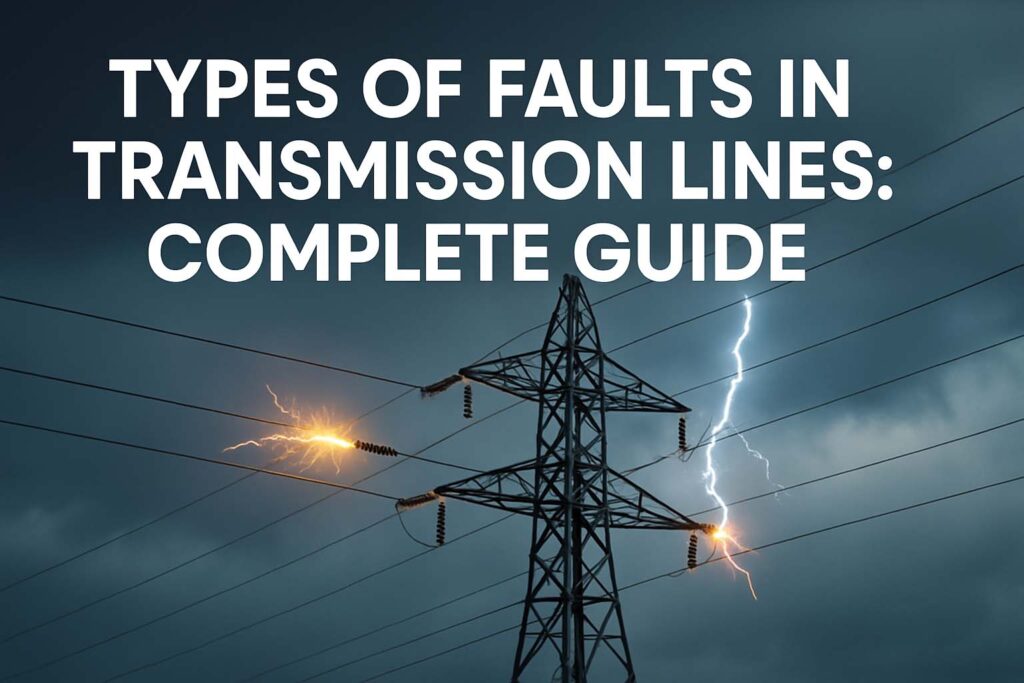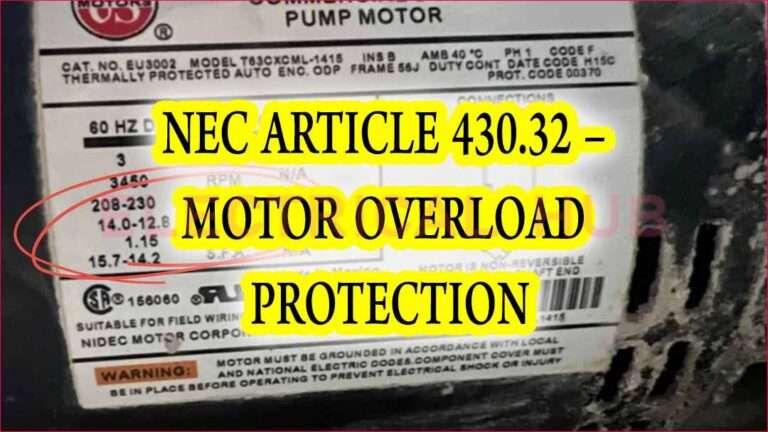Types of Faults in Transmission Lines: Complete Guide
Transmission lines are vital in transferring electric power from generation to distribution networks. But these lines often face disturbances called faults. Faults disturb the normal flow of current and can damage equipment if not cleared quickly.

This article covers the types of faults in transmission lines, their characteristics, causes, and effects on the power system. We’ll also touch on related concepts like fault current calculation, short circuit behavior, and transmission line parameters.
What is a Fault in Transmission Lines?
A fault occurs when the insulation between two or more conductors breaks down, causing unintended current flow. This may result from lightning strikes, insulation failure, equipment damage, or human errors.
Faults in transmission lines lead to:
- Sudden voltage drops
- Abnormal current (also known as fault current)
- System instability
- Equipment failure if not cleared on time
Understanding the types of faults in transmission lines helps power engineers design better protection systems.
Classification of Transmission Line Faults
Transmission line faults are broadly classified into two categories:
- Symmetrical Faults
- Unsymmetrical Faults
Let’s explore each in detail.
Symmetrical Faults
Symmetrical faults involve all three phases equally. They are rare but severe, causing large fault currents. The most common symmetrical fault is the three-phase fault.
Three-Phase Fault (L-L-L)
In this fault, all three phases (R, Y, B) are shorted together. Sometimes, they are also shorted to ground. This is the most severe type because it creates the highest fault current and short circuit current.
Characteristics:
- Balanced system during the fault
- Maximum damage potential
- Often used in fault current calculation to design protection devices
Though rare, it helps engineers test worst-case scenarios in protection design.
Unsymmetrical Faults
These faults involve one or two phases. They are more common in real-world systems.
Single Line-to-Ground Fault (L-G)
Occurs when one phase touches the ground. It is the most frequent fault in transmission lines.
Causes:
- Lightning
- Insulator flashover
- Tree branches falling on the line
Effects:
- Unbalanced system
- High fault current in the affected phase
- Can cause fault current distribution in star delta connected transformers to vary
Line-to-Line Fault (L-L)
Occurs when two phases are shorted together. This can happen due to conductor swinging or equipment failure.
Characteristics:
- Moderate fault current
- Affects phase voltages
- Asymmetrical fault
Double Line-to-Ground Fault (L-L-G)
Happens when two lines touch the ground together. It’s more damaging than a single line-to-ground fault but less severe than a three-phase fault.
Impacts:
- Unbalanced voltages and currents
- Requires advanced relays to detect and isolate
Here’s a summary table for quick reference:
| Fault Type | Phases Involved | Severity | Frequency | Nature |
|---|---|---|---|---|
| L-G | 1 + Ground | Low | High | Unsymmetrical |
| L-L | 2 | Medium | Medium | Unsymmetrical |
| L-L-G | 2 + Ground | High | Medium | Unsymmetrical |
| L-L-L | 3 | Very High | Rare | Symmetrical |
Temporary vs Permanent Faults
Temporary faults are short-lived and often clear themselves. For example, lightning-induced flashovers usually disappear after a cycle or two.
Permanent faults, on the other hand, require intervention. These faults are caused by broken conductors, fallen poles, or damaged insulators.
Open Circuit Faults
While not technically a fault involving short circuits, open conductor faults are also significant. They occur when one or more conductors break. They lead to:
- Load imbalance
- Overheating in transformers
- Voltage rise in healthy phases
Though there’s no arc or high current, the system becomes unstable and must be fixed.
Impact on Fault Current and Protection Design
Different types of faults in transmission lines produce different fault current magnitudes. This variation is critical for protection system design.
For example, hvdc transmission lines require unique protection compared to traditional AC systems. Since HVDC has no natural zero-crossing, the fault current doesn’t stop unless interrupted forcibly. Special HVDC converter transformers are used in such systems to manage voltage and current under faults.
Moreover, the fault current distribution in star delta transformers also differs for each fault type. Protection relays must be set considering these variations to detect and isolate faults effectively.
Transmission Line Parameters and Their Role in Fault Analysis
Each transmission line has parameters like:
- Resistance (R)
- Inductance (L)
- Capacitance (C)
- Conductance (G)
These transmission line parameters affect how fault currents behave and propagate. Long transmission lines may show different behaviors than short ones due to distributed capacitance and inductance.
In fact, different types of transmission lines (overhead, underground, HVDC) react differently to faults. For instance, underground cables have higher capacitance and may show delayed fault detection.
Fault Detection Methods
Detecting faults quickly is crucial. Here are some commonly used methods:
- Distance Protection: Uses impedance to locate fault
- Differential Protection: Compares current at both ends of the line
- Overcurrent Relays: Trip when current exceeds a preset level
- Travelling Wave Protection: Detects fast wavefront changes in ultra-high voltage lines
For accurate fault current calculation, tools like simulation software or analytical methods (Thevenin’s theorem, per unit system) are used.
Modern Challenges in Fault Management
With the integration of renewable energy, managing faults has become more complex. Solar panels and wind turbines introduce variability in current flow. Also, types of transmission lines now include hybrid AC-DC systems, which require separate protection schemes.
Additionally, HVDC converter transformers must handle high voltages and switching transients during faults. These need to be robust, and their protection systems highly responsive.
Conclusion
Understanding the types of faults in transmission lines is essential for designing resilient power systems. From common single line-to-ground faults to rare three-phase faults, each type has unique characteristics.
Whether you are analyzing fault current and short circuit current, selecting relays, or studying fault current distribution in star delta configurations, this knowledge will help you create more reliable systems.
Follow Us on Social:
Subscribe our Newsletter on Electrical Insights to get the latest updates in Electrical Engineering.
#TransmissionLineFaults, #PowerSystemFaults, #ElectricalEngineering, #TransmissionLines, #LineFaultDetection, #ShortCircuitAnalysis, #OpenCircuitFaults, #EarthFaults, #ElectricalFaultTypes, #PowerTransmission, #HighVoltageEngineering, #ProtectionRelays, #SubstationProtection, #EnergyInfrastructure, #FaultClassification





